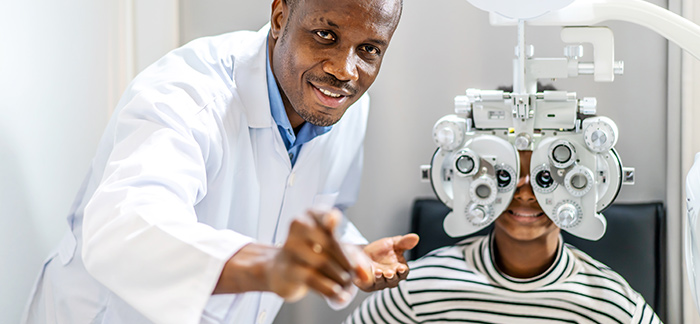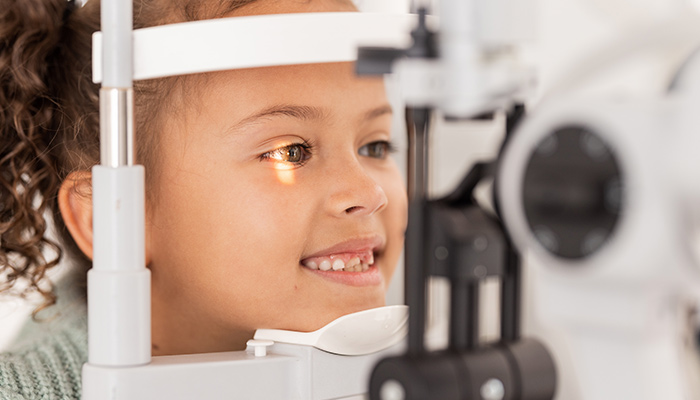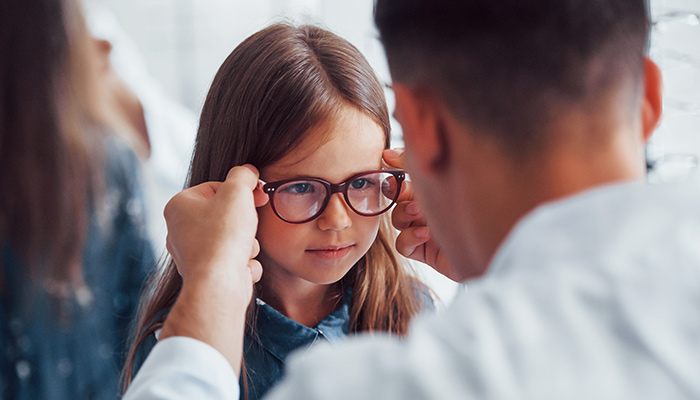
Your child’s eyes are the window to their world. In children’s early years, growth and visual development are rapid and vast. Routine eye tests help detect any vision problems early enough to minimise possible damage, and can treat them faster and more effectively. Through regular eye checks, you’re teaching your child eye health and helping preserve their long-term vision, which can only benefit their overall wellbeing.
How early should I start testing my child’s eyes?
You can start testing your child’s eyes at six months old. Eye testing in children aged one and younger checks how your child’s eyes move, ensures they’re lined up correctly and also assesses how their eyes react to changes in light and darkness.
Children can have their first comprehensive eye exam at age three, and every two years going forward. If their eye doctor has any concerns, more frequent eye tests may be necessary.
Why should I test my child’s eyes?

Testing your child’s eyes can help to:
1. Calculate clarity and sharpness
A physical eye exam and vision screening uses eye chart tests, letters and pictures to assess how well your child sees objects’ form and detail (known as visual acuity). An optometrist might ask your child to identify the direction to which the letter “E” opens, by imitating through finger gestures the letter they see.
2. Detect childhood eye diseases
Your child might not tell you their vision is blurry if they think nothing’s wrong or don’t know anything different. It’s not uncommon for symptoms to go unnoticed by both parents and teachers. Left untreated, infections, refractive errors and misaligned eyes can harm your child’s vision.
Eye testing can help diagnose:
- amblyopia/lazy eye (partial development in the brain area for one eye makes one eye weaker)
- astigmatism (an irregularly curved cornea, leading to blurry vision)
- hyperopia (far-sightedness)
- myopia (near-sightedness)
If your child has vision problems, eye tests can help remedy these with spectacles or contact lenses. The right prescription spectacles can assist with correcting refractive errors.
3. Support learning and academic success
Poor vision can hinder your child’s reading abilities. If left uncorrected, it can also impact them physically on the sports field as well as emotionally. Vision can influence your child’s academic success in school, university and the future workplace. By testing your child’s eyes at an early age, you can potentially prevent the effect poor vision can have on your child’s literacy and performance levels scholastically and beyond.
How do I know my child needs an eye test?
Notice how your child observes things around the home and both inside and outside the classroom.

Your child probably needs an eye test if they:
- demonstrate challenging body-eye or hand-eye coordination
- lose their place when reading
- how unusually low attention or interest in close activities (e.g. colouring, puzzles, reading)
- sit very near the blackboard or TV
- squint or show other signs of discomfort (e.g. rub eyes often, are light-sensitive)
- tilt/turn their head to look at something in front of them
How can I prepare my child for their first eye test?
Going to an optometrist for the first time can be overwhelming. Try encouraging and reassuring your child by reading a story in which the character goes to the eye doctor. You can also describe what the eye doctor might ask your child to do, and explain that they might receive eye drops, but that these aren’t painful and don’t involve needles.
How can I teach my child eye care and safety?

Try incorporating these six top tips into your daily life to help teach your child good eye care:
- Be screen smart – Excessive screen time can negatively impact your child’s sleep and physical activity. With limited screen time, your child can also help lower their risk of myopia and digital eye strain. Remember the 20-20-20 rule: Look up from the screen after 20 minutes, and focus on something at least 20 feet away for 20 seconds. Children younger than five should have less than an hour’s screen time daily, while older kids should have an hour maximum.
- Eat well – Maintain a balanced and healthy diet of eggs, fish, fresh vegetables, fruit and meat. Green leafy vegetables and yellow vegetables are Vitamin A-rich and promote good eye health.
- Play outdoors – Outside activities can discourage the onset and progression of myopia. Instead of indoor games or video games, encourage your child to be in nature more often.
- Protect and prevent eye injuries – Keep your child’s eyes protected with UV filter sunglasses and ensure they wear a helmet to prevent physical injuries and swimming goggles when playing in water. Protective sports goggles can help prevent eye injuries.
- Stay hydrated – Our eyes need water to be cleaned. Encourage your child to drink at least four full glasses of water a day, also taking into consideration their age and activities.
- Wear prescription spectacles and contact lenses correctly – Teach your child the correct way to wear spectacles and contact lenses, and keep an eye on their prescription renewal. Encourage them to use spectacles while reading but to remove them before playing games to avoid injuries.
Just like your child learns the importance of eating healthily and brushing their teeth, you can help them to incorporate good vision habits from an early age. If you have any concerns regarding your child’s vision, book an eye test with a Spec-Savers optometrist today. By prioritising your child’s vision and wellness, they can benefit from healthy eyes and enjoy a fuller life both now and in the future.
Date Published: 11 January 2023